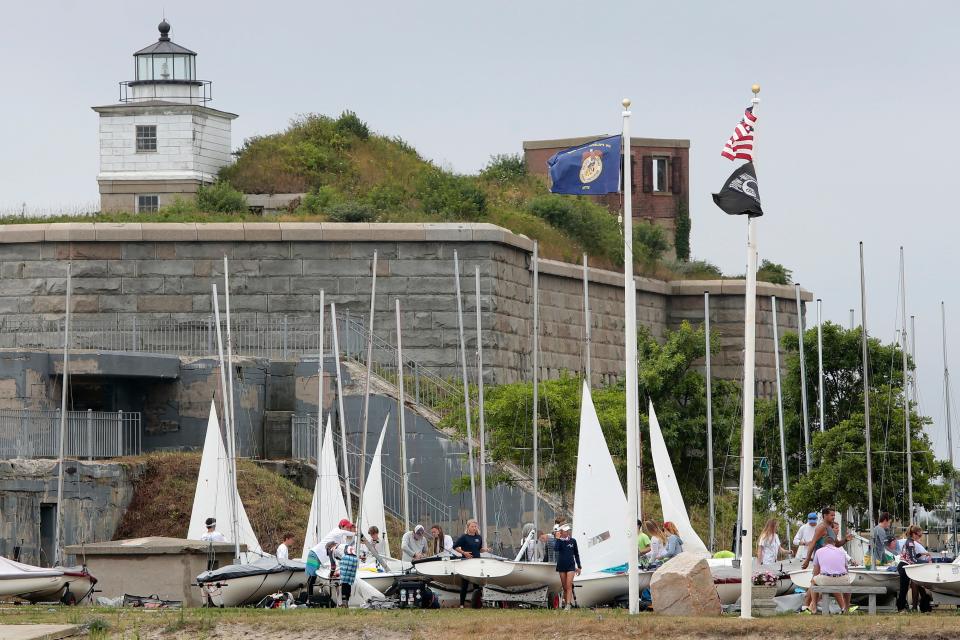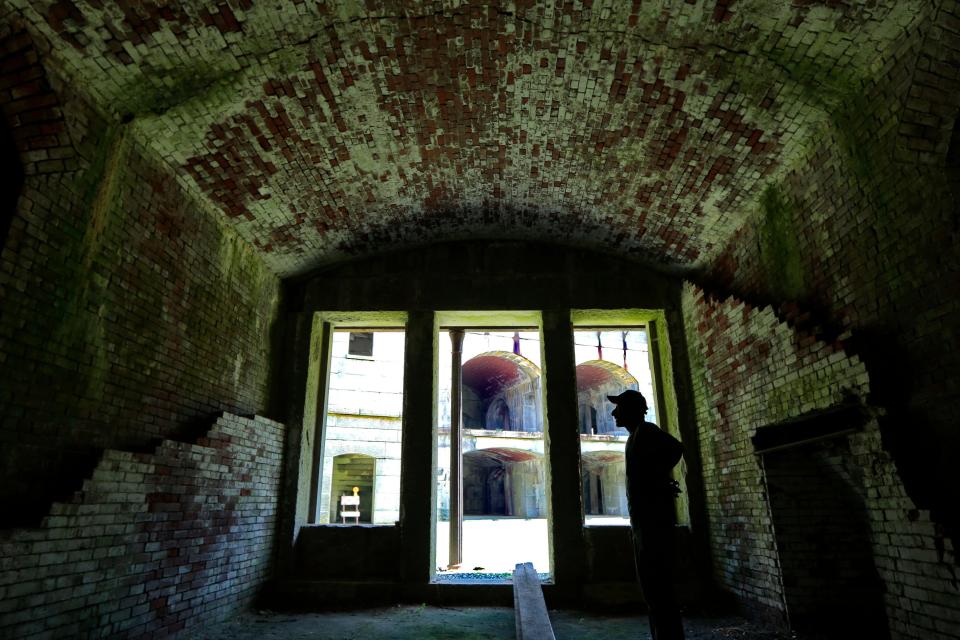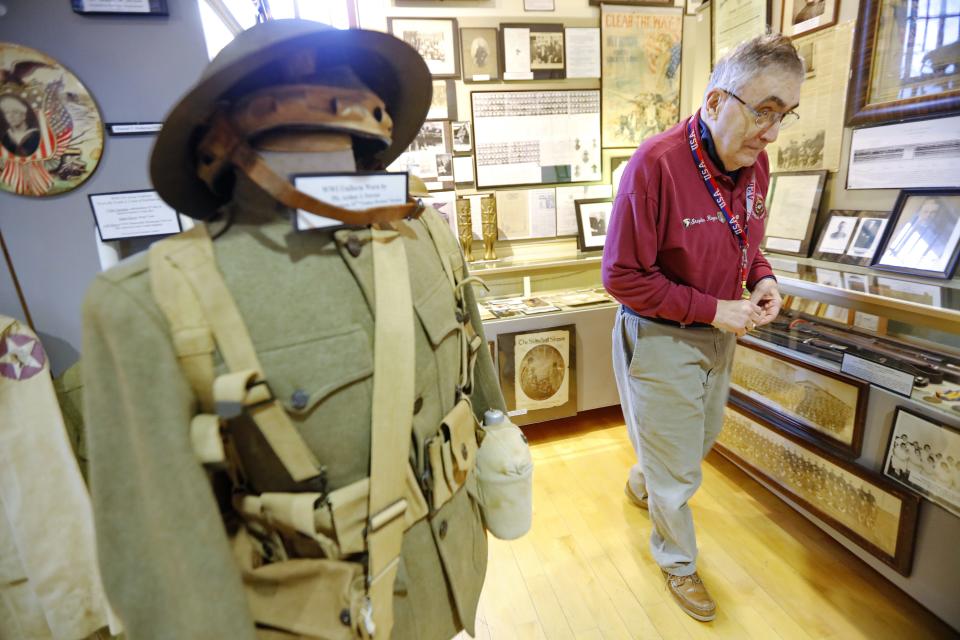Curious SouthCoast: Is it Fort Taber or Fort Rodman? Why this New Bedford fort has 2 names
NEW BEDFORD — The sign on the highway heading into New Bedford reads "Historic Fort Taber," but that’s not exactly accurate.
It’s not historically accurate, although it is commonly known by that name. More accurately, it’s Fort Rodman at Fort Taber Park.
Fort Taber-Fort Rodman Historical Association president and archivist Bill Niedzwiedz and historian Brian Ruh are committed to setting the record straight, as much as they can, about the history of the site.
The stone fort at Clark’s Point that stands today was never officially named Fort Taber. It was, however, officially named Fort Rodman by the federal government in July 1898 as part of the Fort Rodman Military Reservation. It was never completed when plans for another tier were scrapped.
“That’s the official name,” Niedzwiedz said. “That’s why we keep on going back and forth with this Fort Taber-Fort Rodman. People say, oh, it was always Fort Taber first, but I say that’s not the official name.”

Who was Lt. Col. William Logan Rodman?
Lt. Col. William Logan Rodman was the highest ranking soldier from New Bedford to be killed in action during the Civil War in Port Hudson, Louisiana. Rodman died leading his men in battle during the assault on Port Hudson, Louisiana, and is buried in Oak Grove Cemetery in New Bedford.
Remember the Schamonchi ferry?: Here's where it is now.
The man who inspired the name Fort Taber is New Bedford Mayor Issac C. Taber, who led the city from 1860 to 1862, upon his death.
Niedzwiedz says the property has really had four names, officially and unofficially, and that they are Fort Rodman, Fort Taber, Clark’s Point and the Allen Farm. He maintains that nobody knows who Clark was, but it was originally the Allen Farm in 1690.
History of Clark's Point
In the 18th century almost all of the land was owned by the Allen Family, Ruh said, reading from one account of the family’s history. In 1800 Benjamin Allen’s grandson Francis Allen sold an acre at the tip of the point to the federal government for the construction of a lighthouse.
In 1797, with the fleet of whaling ships coming in and out, the first wooden lighthouse called Clark’s Point Lighthouse was built, but it only lasted for a year. As the story goes, it burned to the ground, fueled by a bird smashing into whale oil lamps. The second wooden lighthouse also burned down after a few years. The third, a stone lighthouse, lasted until 1869.
In 1857, the Army Corps of Engineers was looking at places to put forts to protect the coast. During the Revolutionary War, a British fleet had invaded and destroyed New Bedford’s fleet of whaling ships. A coastal defense was also needed during the War of 1812. The fort didn’t go in until 1852.
The federal government signed off on the location for a permanent military installation that it was looking for to help protect the coast when it purchased farmland on Clark’s Point.
Around 1860, the fort still hadn’t been completed, and the Civil War broke out. New Bedford was such a prosperous community from its success in the whaling industry, Ruh said, and the residents were afraid the Confederates would come and raid the fort. That’s why they first constructed an earthworks fort.
How Fort Taber came to be
The Army Corps decided to build a more substantial fort, obscuring the view of the earthworks fort. Ruh said another reason the Taber name stuck was because the earthworks fort was often referred to as Fort Taber. It ultimately became obsolete.
Southcoast Wonders: Dartmouth's Lincoln Park was a summer hotspot — but why did it close?

New Bedford was granted 47 acres by the federal government with a request that an educational facility tell the story of the property. Niedzwiedz said Fort Rodman was an official military installation with active Army Reserves until 1990. Fort Rodman has been declared unsafe.
Learn more at the museum
The original Fort Taber Historical Association was formed in 1972. In 2004, the city asked the association to open a museum. It started out with a large model of the fort, a table and 12 pictures and has continued to grow in its present home. The last expansion was in 2009.
At the military museum, the focus is on the people who served in the wars the U.S. military fought, Ruh and Niedzwiedz, a retired Army staff sergeant who served for 23 years, agree. Entry to the military is free, with donations requested. A virtual tour of Fort Rodman is available online at www.forttaber.org.

Niedzwiedz said it’s the people who ask questions about the history of the location and want to be accurate who are more likely to call it Fort Rodman.
“This is where we always run into it,” he said. “Do we really worry about it, no, but we always like to explain to them it really isn’t Fort Taber. The federal government named it after a war hero.”
Standard-Times staff writer Kathryn Gallerani can be reached at kgallerani@wickedlocal.com. Follow her on Twitter: @kgallreporter. Support local journalism by purchasing a digital or print subscription to The Standard-Times today.
This article originally appeared on Standard-Times: Fort Rodman? Fort Taber? Which is it, or is it both?

